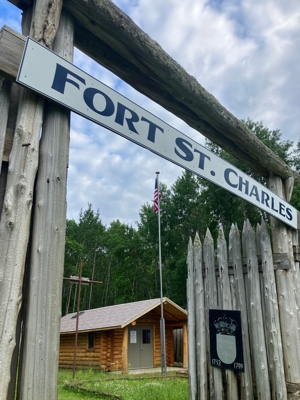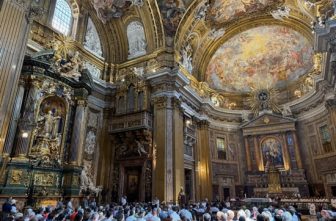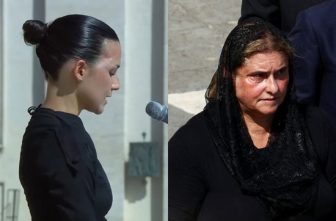
One of Church’s earliest outposts in Minnesota now a rustic retreat for priests, pilgrims
At the very northern tip of Minnesota, tucked in the woods on a remote island, sits an unassuming log chapel. Its story is almost as old as the story of the Catholic faith in Minnesota. It is the northernmost place of worship in the contiguous United States and is located on the same spot as the original chapel of Fort St. Charles, an 18th-century French fur trading post.
While still not widely known, Fort St. Charles is one of the most historically and spiritually valuable Catholic sites in Minnesota. It stands as a testament to the great evangelistic courage of the state’s forefathers in the faith, who risked their lives because of the hope they had in eternal life in Christ and because of their commitment to passing on the good news of that life with the land’s Indigenous people and the future generations to come. During this Jubilee Year, with its theme Pilgrims of Hope, a pilgrimage to Fort St. Charles can be a powerful encouragement in that hope.
Founded in 1732 by French Canadian voyageurs, the fort offers a window into the earliest days of Christianity in Minnesota and stands as a testament to the life of Jesuit Father Jean-Pierre Aulneau, one of Minnesota’s earliest heroes of the faith.
Fort St. Charles — located on Magnuson’s Island just off the north shore of the Northwest Angle — is only accessible by boat or snowmobile. From the Twin Cities, the trip by car takes seven hours, not including the required border crossings into and out of Canada along the way. It is an ambitious trek, but nothing compared to the voyageurs’ journeys through the inhospitable wilderness centuries ago.
French Canadian adventurer Pierre La Vérendrye established the fort as part of his effort to find the Northwest Passage. That mission was unsuccessful, but the fort became an important fur trade site and a launching point for some of the farthest expeditions west at the time.
La Vérendrye also introduced the Catholic faith to the region. Minnesota’s first Catholic church — St. Michael’s chapel at the French Fort Beauharnois near modern-day Lake City — had been built only five years earlier. The chaplain at Fort St. Charles ministered to the voyageurs’ spiritual needs and evangelized local Native American tribes.
Father Aulneau was one of the first chaplains. He arrived in Quebec in 1734 at the age of 29 and set off from Montreal by canoe with La Vérendrye on his next journey west. Despite the dangers of missionary work found in uncharted wilderness, extreme weather and violence, Father Aulneau was filled with Christian hope. In his journal, he wrote, “I should deem myself happy if I should be worthy of laying down my life for the One from whom I received it.”
While seeking help during a desperate food shortage at the fort, Father Aulneau and 21 others were captured and killed during a time of frequent conflict between Indigenous people and Europeans. A search expedition recovered their bodies on what became known as Massacre Island just across the modern Canadian border. Father Aulneau’s body was in a kneeling position as though in prayer. Their bodies were brought back to the fort for burial.
The French fur trade ceased in the 1750s and the fort was abandoned. It was nearly lost forever. In 1889, a chance encounter in France between Jesuit priests and a relative of Father Aulneau led to the discovery of some of Father Aulneau’s letters. Jesuits at St. Boniface College, a French-language university in Winnipeg, Manitoba, took an interest in rediscovering Fort St. Charles. In 1908, after decades of searching, they uncovered the ruins, now completely overtaken by the elements. Father Aulneau’s body was taken to Winnipeg, where it now rests at the Cathedral of St. Boniface.
In 1949, members of the Knights of Columbus set out to preserve this treasure of Minnesota’s Catholic heritage. The Knights worked in tandem with the late Father Emmett Shanahan, pastor of St. Mary in nearby Warroad and author that same year of “Minnesota’s Forgotten Martyr,” a book on the life of Father Aulneau. The Knights estimate working 250,000 to 300,000 total hours in the roughly 75 years since they took on the project.
Visitors to the site today will find reconstructed versions of the original stockade and bastions. Markers on the grass show outlines of the site’s original buildings. In 2019, the Knights finished construction of a new chapel.
The site features several cabins as well. Part of the Knights’ goal in reconstructing the fort was to offer priests a vacation getaway. Priests can book stays at the fort for themselves and accompanying groups of guests for free.

One priest who has made good use of the opportunity is Father Gregory Mastey, pastor of three churches near Holdingford in Stearns County in the Diocese of St. Cloud. He’s visited Fort St. Charles with friends almost every summer for nearly 30 years. While there, he enjoys fishing, campfires, conversation and prayerful relaxation. “It’s a beautiful area that’s unlike anything right here (in this area),” he said. “God who created us is found in beauty, and it’s a place for us to really go and connect with that beauty.”
Eight groups visited last year, said John Leesch, a Knight from Alexandria who readies the site for visitors every spring and prepares it for winter every fall. Another Knight, Jim Andrie, estimated that 1,200 to 1,500 people sign the guestbook each year. The Knights hope that the word spreads so that more people can take advantage of the opportunity. While the cabins are reserved exclusively for priests and their guests, the fort is open for all.
Priests can reserve a stay at Fort St. Charles by contacting Andrie at jim.andrie@hotmail.com. For more information, visit fortstcharles.com.



